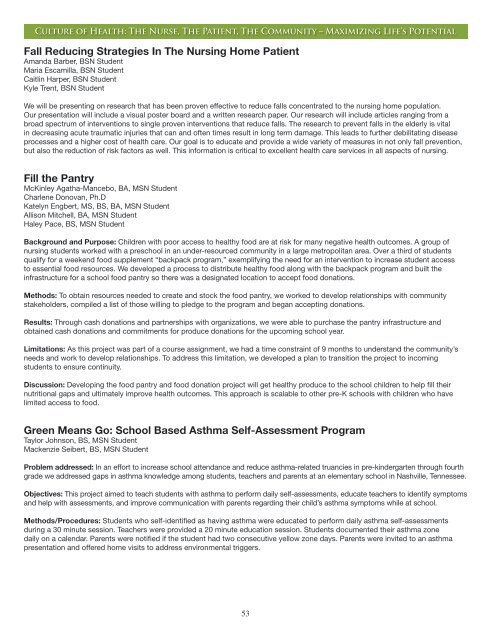2016 TNA–TASN Joint Conference
Create successful ePaper yourself
Turn your PDF publications into a flip-book with our unique Google optimized e-Paper software.
Culture of Health: The Nurse, The Patient, The Community – Maximizing Life’s Potential<br />
Fall Reducing Strategies In The Nursing Home Patient<br />
Amanda Barber, BSN Student<br />
Maria Escamilla, BSN Student<br />
Caitlin Harper, BSN Student<br />
Kyle Trent, BSN Student<br />
We will be presenting on research that has been proven effective to reduce falls concentrated to the nursing home population.<br />
Our presentation will include a visual poster board and a written research paper. Our research will include articles ranging from a<br />
broad spectrum of interventions to single proven interventions that reduce falls. The research to prevent falls in the elderly is vital<br />
in decreasing acute traumatic injuries that can and often times result in long term damage. This leads to further debilitating disease<br />
processes and a higher cost of health care. Our goal is to educate and provide a wide variety of measures in not only fall prevention,<br />
but also the reduction of risk factors as well. This information is critical to excellent health care services in all aspects of nursing.<br />
Fill the Pantry<br />
McKinley Agatha-Mancebo, BA, MSN Student<br />
Charlene Donovan, Ph.D<br />
Katelyn Engbert, MS, BS, BA, MSN Student<br />
Allison Mitchell, BA, MSN Student<br />
Haley Pace, BS, MSN Student<br />
Background and Purpose: Children with poor access to healthy food are at risk for many negative health outcomes. A group of<br />
nursing students worked with a preschool in an under-resourced community in a large metropolitan area. Over a third of students<br />
qualify for a weekend food supplement “backpack program,” exemplifying the need for an intervention to increase student access<br />
to essential food resources. We developed a process to distribute healthy food along with the backpack program and built the<br />
infrastructure for a school food pantry so there was a designated location to accept food donations.<br />
Methods: To obtain resources needed to create and stock the food pantry, we worked to develop relationships with community<br />
stakeholders, compiled a list of those willing to pledge to the program and began accepting donations.<br />
Results: Through cash donations and partnerships with organizations, we were able to purchase the pantry infrastructure and<br />
obtained cash donations and commitments for produce donations for the upcoming school year.<br />
Limitations: As this project was part of a course assignment, we had a time constraint of 9 months to understand the community’s<br />
needs and work to develop relationships. To address this limitation, we developed a plan to transition the project to incoming<br />
students to ensure continuity.<br />
Discussion: Developing the food pantry and food donation project will get healthy produce to the school children to help fill their<br />
nutritional gaps and ultimately improve health outcomes. This approach is scalable to other pre-K schools with children who have<br />
limited access to food.<br />
Green Means Go: School Based Asthma Self-Assessment Program<br />
Taylor Johnson, BS, MSN Student<br />
Mackenzie Seibert, BS, MSN Student<br />
Problem addressed: In an effort to increase school attendance and reduce asthma-related truancies in pre-kindergarten through fourth<br />
grade we addressed gaps in asthma knowledge among students, teachers and parents at an elementary school in Nashville, Tennessee.<br />
Objectives: This project aimed to teach students with asthma to perform daily self-assessments, educate teachers to identify symptoms<br />
and help with assessments, and improve communication with parents regarding their child’s asthma symptoms while at school.<br />
Methods/Procedures: Students who self-identified as having asthma were educated to perform daily asthma self-assessments<br />
during a 30 minute session. Teachers were provided a 20 minute education session. Students documented their asthma zone<br />
daily on a calendar. Parents were notified if the student had two consecutive yellow zone days. Parents were invited to an asthma<br />
presentation and offered home visits to address environmental triggers.<br />
53

















